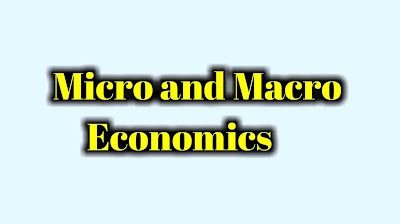Difference between microeconomics and macroeconomics
 |
| Micro and Macro economics |
The subject Matter of economics habeen studied under two broad branches:-
1.Microeconomics 2.Macroeconomics
These two concept have become of general use in economics.Let us discuss these concepts in detail.
Macroeconomics is that part of economic theory which studies the behaviour of aggregates of the economy as a whole .For example National income, aggregate output etc.Its main tools are Aggregate Demand and Aggregate Supply.
Micro vs Macro
*In Microeconomics, the letter ‘I’ stand for ‘individuals’ .It studies the economic behaviour of individuals.
*In Macroeconomics,the letter ‘A’ stand for ‘Aggregate’.It studies the economy as a whole .
Difference between microeconomics and macroeconomics
Microeconomics :-
Meaning –Microeconomics is that part of economic theory which studies the behaviour of an economy.
Tools – Demand and Supply
Basic Objective-
Its purpose is to determine the value of a commodity or factors of production.
Degree of Aggregation – This involves a limited amount of aggregation. For example, market demand is obtained by aggregating the individual demands of all buyers in a particular market.
Basic Assumption-It assumes all the macro variables to be constant,it assumes that national income, consumption, saving etc are constant .
Other Name –It is also known as ‘Price Theory’.
Example –Individual income, individual output .
Macroeconomics :-
Meaning –Macroeconomics is that part of economic theory which studies the behaviour of aggregates of the economy as a whole .
Tools –Aggregate Demand and aggregate Supply .
Basic Objective –aim to determine income and employment level of the economy .
Degree of Aggregation –It involves the highest degree of aggregation.For example, aggregate demand is derived for the entire economy .
Basic Assumption –It assumes that all the micro variables like decisions of households and firms, prices of individual products etc are constant.
Other Name – It is also known as ‘Income and Employment theory .
Examples- National income , National output.